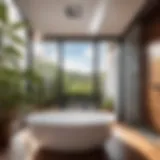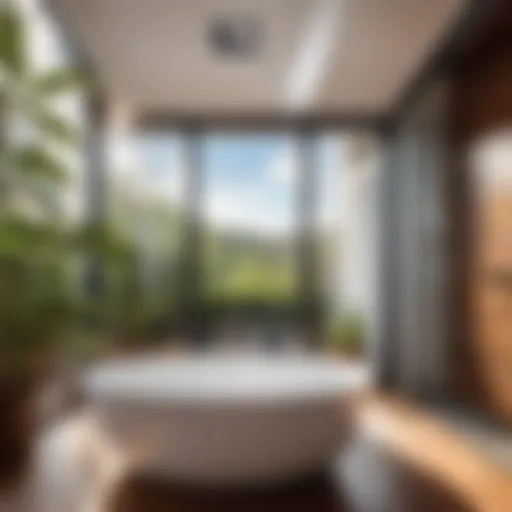Vintage Bathroom Aesthetics: A Visual Exploration
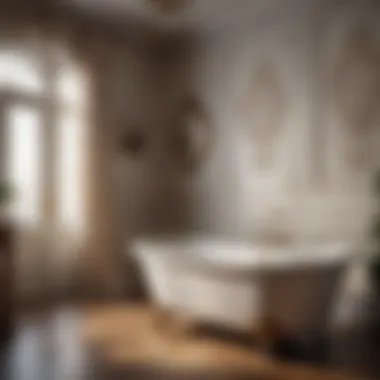

Intro
Vintage bathrooms hold a unique charm that transcends mere aesthetics. They encapsulate history, culture, and personal stories, serving as portals to times long past. As we analyze vintage bathroom photographs, we uncover a tapestry of design evolution and cultural significance. These visuals not only provide inspiration but also evoke deeper emotional responses connected to memory and nostalgia.
By understanding various styles, fixtures, and materials used in vintage bathrooms, we can appreciate their relevance today. Moreover, as modern designs often recycle elements from the past, recognizing these influences can enrich our own bathroom spaces. The following sections will guide you through the materials needed, detailed DIY steps, technical aspects, and the complete process of engaging with vintage bathroom aesthetics.
Materials:
A successful vintage bathroom project begins with the right materials. Below is a comprehensive list:
- Ceramic tiles: 12" x 12"
- Paint: An exterior semi-gloss in vintage pastel shades, approx. 1 gallon
- Vanity mirror: Vintage-style, size of your choice, around 24" x 36"
- Faucets: Pair of antique-style sink faucets
- Lighting fixtures: Two wall sconces, preferably brass or chrome
- Shower curtain: Floral pattern, preferably cotton, size based on your shower dimensions
- Accessories: Towel racks, soap dishes, and toilet paper holder in vintage design
Ensure each item aligns with your vision for a cohesive outcome. Consider sourcing materials from thrift stores, flea markets, or online marketplaces for authenticity.
DIY Steps:
1. Planning
Begin by envisioning the overall style of your vintage bathroom. Sketch a layout or create a mood board to visualize your goals. Research specific elements, color palettes, and historical designs to guide your choices.
2. Painting the Walls
Preparation is crucial:
- Clean walls thoroughly.
- Apply primer if necessary.
- Use a roller to paint the base coat in your chosen vintage pastel shade. Allow it to dry completely before applying a second coat if needed.
3. Installing Tiles
Start from the center and work your way out.
- Cut tiles as needed for corners using a tile cutter.
- Mix mortar according to package instructions.
- Apply the mortar with a trowel and place tiles in desired pattern, ensuring they are level.
- After setting, apply grout between tiles, wiping excess with a damp sponge.
4. Pasting Accessories
- Fix the vanity mirror with adhesive hooks or mounting hardware.
- Install towel racks and the soap dish in convenient locations, ensuring they suit your vintage theme.
5. Adding Fixtures
Faucets and lighting should be installed as follows:
- Turn off water supply before replacing faucets.
- Follow manufacturer's instructions for installation.
- Secure wall sconces to appropriate height, ensuring wiring is handled safely.
Technical Aspects:
Having the right tools is important:
- Tools needed:
- Timing specifics: Expect a minimum of two days, with additional time for drying between applications.
- Techniques to elevate your design: Incorporate reclaimed wood or repurposed vintage items to personalize your space further. For instance, using old barn wood for shelving can emphasize the vintage look.
- Tile cutter
- Hammer
- Screwdriver set
- Paint roller
- Level
- Grout float
DIY Project Process:
Installation Method
- Begin by installing large items, such as the vanity and tub.
- Proceed to smaller installations, keeping a checklist for each completed item.
Troubleshooting Tips
If you encounter issues, consider these solutions:
- If tiles do not align, double-check your measurements and reposition if necessary.
- In case of paint drips, allow drying and gently sand for a smoother finish.
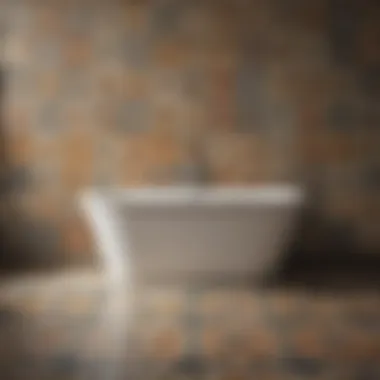

Through this exploration, you will engage with the aesthetic beauty of vintage bathrooms while creating a space that resonates with personal and historical significance. This approach allows one to not just appreciate the design but also to interact with it on a deeper level.
Preface to Vintage Bathroom Pictures
Vintage bathroom pictures offer a unique window into the past. They serve not only as visual representations of aesthetic preferences but also tell stories about cultural shifts and societal norms. Examining these photographs allows homeowners and enthusiasts to appreciate the intricate designs that define particular eras. By exploring vintage styles, one can draw inspiration for modern bathrooms, marrying functionality with artistic expression. This article aims to elucidate the relevance of vintage aesthetics and how they can influence contemporary design choices.
Defining Vintage in the Context of Bathrooms
When discussing vintage bathrooms, we often refer to designs that evoke a sense of nostalgia. The term "vintage" typically applies to styles from around the early to mid-20th century, particularly those flourishing from the 1920s to the 1970s. This definition encompasses a wide range of design elements including tiles, paint colors, and fixtures that have become timeless in appeal.
Key vintage styles include Art Deco, characterized by geometric shapes and bright colors, and more subdued Victorian designs that emphasize intricate details and ornate decorations. Such characteristics allow for a diverse interpretation of vintage aesthetics, making it possible for modern homeowners to select features that resonate with their personal style while retaining historical significance.
The Appeal of Vintage Bathroom Aesthetics
Vintage bathroom aesthetics attract homeowners for several reasons. First, they provide a sense of history and permanence, qualities often lacking in contemporary designs. The unique materials and craftsmanship evident in vintage styles represent an era when details mattered. They contrast sharply with today’s mass-produced designs that prioritize speed and cost over artistry.
Moreover, many homeowners find comfort in designs that echo simpler times. Vintage elements can evoke feelings of warmth and homeliness, creating a sanctuary within a hectic world.
Furthermore, integrating vintage features into bathroom designs can also be a sustainable choice. Choosing to restore vintage fixtures or reuse materials contributes to recycling efforts, thus minimizing environmental impact. Here lies a double benefit: preserving history while promoting eco-conscious choices.
Historical Context of Bathroom Design
Understanding the historical context of bathroom design is essential to appreciate the evolution of vintage bathroom aesthetics. This aspect reveals how social norms, technology advancements, and design philosophies have converged to shape what we now consider vintage. By examining each period, one can grasp the underlying principles that dictated design choices. This reflection not only informs restoration and renovation practices but also enriches our understanding of domestic spaces. These insights become particularly valuable for housewives and homeowners aiming to harmonize vintage aesthetics with modern functionality.
Early Bathroom Concepts
In the early days of civilization, bathrooms were often rudimentary and functional. They focused mainly on practical needs rather than aesthetics. The use of open spaces for bathing, such as rivers and lakes, highlighted a minimalistic approach to hygiene. With time, the concept of private bathrooms emerged, particularly among the affluent.
The introduction of the first indoor plumbing systems in the 19th century transformed bathroom concepts significantly. The advancements meant that people could enjoy the luxury of private bathing without requiring significant efforts. Such developments paved the way for bathrooms to be integrated into homes, highlighting their importance in domestic life. Early bathroom designs laid the groundwork for future innovations, moving from simple necessity to a space that could embody comfort and style.
The Victorian Influence
The Victorian era marked a dramatic shift in bathroom aesthetics. Society began to value not just hygiene but also beauty and status. Bathrooms started to feature ornate designs, elaborate fixtures, and the use of new materials such as ceramics and glass.
Key characteristics of Victorian bathrooms included:
- Clawfoot Tubs: These standalone bathtubs made a statement and became icons of luxury.
- Intricate Tilework: Patterns and colors were strategically used to enhance visual appeal.
- Brass Fixtures: Faucets and handles were often crafted from brass, showcasing craftsmanship and durability.
During this period, bathrooms became spaces of leisure, reflecting the growing societal emphasis on comfort and personal well-being. The aesthetic of this time was deeply tied to the ideals of elegance and refinement, ensuring that bathrooms were not only functional but also beautiful.
Transformation in the Roaring Twenties
The Roaring Twenties brought forth a more liberated approach to design. Freed from the constraints of earlier periods, bathrooms began adopting bolder styles influenced by Art Deco. This movement emphasized geometric shapes and vibrant colors, marking a departure from the heavy ornamentation of the Victorian era.
Key transformations included:
- Streamlined Furniture: Bathroom vanities and cabinets featured sleek designs, moving away from bulky constructions.
- Vivid Colors: Bright tiles and accessories transformed bathrooms into engaging spaces.
- Electric Innovations: The introduction of electric lighting allowed for more playful designs and better functionality.
The emerging culture of modernity embraced a sense of freedom and creativity, allowing bathrooms to showcase personality and aesthetic preferences. This period influenced subsequent generations, underscoring the idea that bathrooms could be stylish expressions of personal taste.
Key Characteristics of Vintage Bathroom Pictures
Understanding the key characteristics of vintage bathroom pictures enriches our appreciation of bathroom aesthetics. These images convey not just design choices but also cultural narratives and historical significance. Each characteristic presents unique benefits that can guide homeowners and designers in their quest for creating vintage-inspired spaces. By examining these elements, we can decipher the underlying themes that resonate through the years.
Color Palettes and Design Schemes
Color palettes in vintage bathroom pictures often reflect the trends of their time. Soft pastels such as mint green, baby blue, and pale pink were common in the 1950s, creating a soothing ambiance. In contrast, bolder colors emerged later, such as deep blues and forest greens, particularly notable during the Art Deco movement.
- Benefits of a Well-Defined Color Palette:
- Creates a consistent theme and atmosphere.
- Helps in evoking nostalgia and warmth.
- Individual colors may enhance natural light and spatial perception.
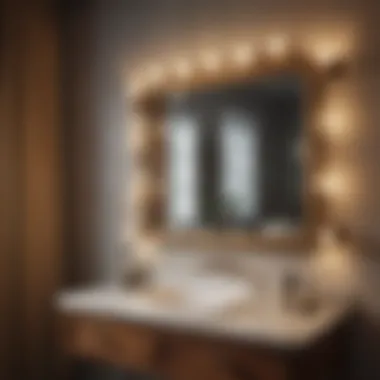

In addition to colors, the overall design scheme plays a crucial role. Patterns such as floral wallpaper or geometric tiles enhance the design, capturing the spirit of vintage charm.
Fixtures and Fittings
The fixtures and fittings in vintage bathrooms often tell a story of craftsmanship and design philosophy. Elements like clawfoot tubs, pedestal sinks, and vintage faucets not only serve a functional purpose but also stand as artistic expressions.
- Importance of Quality Fixtures:
- Durable and timeless designs contribute to longevity.
- Truly vintage pieces add authenticity and character to the space.
- Well-chosen fixtures can increase property value and aesthetic appeal.
When planning your bathrooms, consider incorporating original or reproduction fittings that align with the vintage theme. This authenticity enriches the overall atmosphere and brings a sense of history into present-day spaces.
Materials and Textures
Materials and textures are pivotal in the construction and final design of vintage bathrooms. From glossy tiles to rich wood, each element plays a part in crafting a cohesive aesthetic. Vintage bathrooms often incorporate unique materials, such as ceramic, glass, and metals that show quality workmanship.
- Key Material Characteristics:
- Ceramic tiles with intricate designs evoke artistry.
- Natural wood finishes enhance warmth and texture.
- High-quality metals for fixtures provide both function and shine.
In addition, combining different textures can create visual interest and depth in the design. Layering materials thoughtfully will enhance the appeal and timelessness of the space, ordering your vintage vision into reality.
"Vintage bathroom pictures reflect not only an aesthetic choice but also a narrative woven through time, offering homeowners a unique way to connect with their living spaces."
Emphasizing these characteristics can empower anyone aiming to achieve a vintage feel in their bathrooms. By giving attention to color, fixtures, and materials, one can create not just a bathroom, but a personal sanctuary wrapped in history and nostalgia.
Categorizing Vintage Bathroom Pictures
Categorizing vintage bathroom pictures is essential in understanding the diverse styles and aesthetics that have shaped bathroom design through the decades. This categorization helps us appreciate the evolution of design trends, the material choices, and the influence of cultural shifts. By segmenting the pictures into distinct categories, one can analyze the unique characteristics that each style brings to the table.
The classification not only aids in understanding the historical context but also serves as a source of inspiration for homeowners and designers alike. It allows them to navigate the sea of options available and select elements that resonate with their personal aesthetic or needs.
Classic Vintage Bath Photographs
Classic vintage bath photographs evoke nostalgia and reflect a time when bathrooms were not merely functional spaces but also places of relaxation and retreat. These images often showcase clawfoot tubs, penny tiles, and ornate fixtures. Such elements transport one back to a period where craftsmanship was paramount.
Classic styles are recognizable by their gentle color palettes. Soft pastels or muted earth tones dominate these designs, creating a calm atmosphere. Additionally, the contrast of rich wood cabinetry against ceramic tiles contributes to the timeless feel of these spaces.
"Classic vintage bathrooms often tell stories of elegance and tranquility that transcend time."
When selecting classic vintage designs, consider elements like:
- Freestanding tubs: These serve as centerpieces, drawing attention and appreciation.
- Intricate moldings: They add depth and detail to walls and ceilings.
- Period-appropriate accessories: Items like vintage mirrors, soap dishes, and linens can enhance authenticity.
Eclectic Vintage Styles
Eclectic vintage styles bring together various influences, making it a versatile category. Such designs often feature bold colors, unique fixtures, and unusual materials, reflecting a more personalized approach. This style allows homeowners to showcase their individuality by mixing and matching elements from different eras.
Eclectic vintage bathrooms often include:
- Mismatched tiles: Using a combination of patterns and colors can create playful contrasts.
- A variety of fixtures: From vintage faucets to retro light fixtures, this style encourages creativity.
- Artwork and accessories: Incorporating pieces from different times invites an artistic flair into the bathroom.
A key benefit of embracing an eclectic approach is the freedom it offers in the design process. One can experiment without strict adherence to specific periods or styles, thus creating a unique space.
Art Deco Inspirations
Art Deco bathroom designs represent a distinctive phase in vintage aesthetics, characterized by bold geometric patterns, luxurious materials, and striking colors. Originating in the 1920s and 1930s, this style offers a glamorous touch to any bathroom. Elements such as chrome fixtures, mirrors with geometric shapes, and rich textiles are hallmarks of Art Deco designs.
The color schemes in Art Deco bathrooms are often more vibrant than in classic styles. Deep blues, greens, and metallics combine to create a sophisticated atmosphere.
When considering Art Deco inspirations, pay attention to:
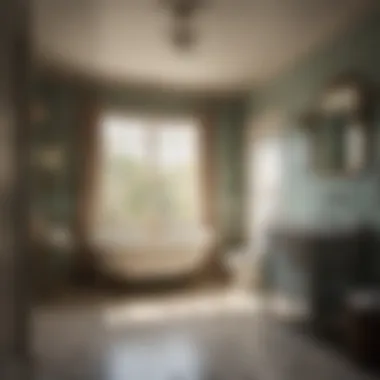

- Symmetry: The designs embrace balanced layouts, drawing the eye across the room.
- Monochromatic palettes: These often incorporate splashes of gold or silver for a touch of luxury.
- Exquisite lighting: Chandeliers or pendant lights that echo geometric designs enhance the overall aesthetic.
In summary, categorizing vintage bathroom pictures provides crucial insights into the various design philosophies and historical contexts behind them. Homeowners can use this knowledge to inform their own renovation choices and embrace the beauty of these timeless styles.
Cultural Significance of Vintage Bathrooms
The cultural significance of vintage bathrooms lies in their ability to reflect the societal norms, values, and aspirations of the times in which they were designed. Through examining vintage bathroom aesthetics, one can garner insight into the evolution of personal hygiene, domestic spaces, and the importance of design in daily life. This section aims to explore how these vintage spaces act as mirrors of their eras, showcasing progress in architecture and design as well as the changing roles of individuals within the household.
Reflections of Societal Trends
Vintage bathrooms often encapsulate the prevailing trends and innovations of their time. For example, the shift from communal bathing during the early decades of the 20th century to the private sanctum of the individual reflects broader societal changes around personal space and privacy. The design elements found within these bathrooms can reveal much about the values placed on cleanliness, luxury, and the comfort of home life.
In the 1920s, the Art Deco movement brought about a wave of modernity and glamor that influenced bathroom design, moving away from utilitarian fixtures to more ornate and visually striking aesthetics. This shift not only illustrated a fascination with the modern world but also an embrace of the femininity that the bathroom space began to symbolize. Moreover, these vintage designs are often infused with joyful colors and shapes that mark a rebellion against the older, more subdued styles.
The Role of Bathrooms in Domestic Spaces
Bathrooms have evolved from simple washrooms to personal retreats, emphasizing the importance of design in utility as well as relaxation. The vintage bathroom reflects the shift in perception about what this space should represent. Functionality is intertwined with aesthetics, and the vintage bathroom becomes an integral part of the home, contributing to a holistic domestic experience.
In many households, the bathroom serves as a refuge where one can escape the busyness of life. It signifies both a personal space and a zone for self-care, which was less emphasized in earlier designs. The fixtures, materials, and layouts of vintage bathrooms highlight this transformation. For instance, clawfoot tubs, pedestal sinks, and intricate tile work from the past remain popular for their charm, making modern renovations feel more comfortable while respecting the past.
Maintaining these vintage elements can also promote sustainability, as many vintage fixtures were designed to last and can be refurbished rather than disposed of. This ties back to a wider trend of valuing longevity and historical appreciation in contemporary designs.
"Vintage bathrooms not only tell a story about past aesthetics, but also about the lives and social structures that informed their designs."
In summary, vintage bathrooms are more than just relics of the past. They are intricate representations of cultural shifts and domestic evolution, providing insight into how restroom aesthetics carry lasting significance in our daily lives.
Using Vintage Bathroom Pictures as Design Inspiration
Vintage bathroom pictures serve as a rich source of inspiration for both homeowners and designers. They encapsulate not only the aesthetic preferences of bygone eras but also the cultural values of those times. By delving into these images, one can uncover a variety of design ideas that blend the charm of vintage aesthetics with the functionality of modern living.
Incorporating Vintage Styles in Modern Bathrooms
To incorporate vintage styles into modern bathrooms, one must first identify specific design elements that resonate with the vintage aesthetic. Color palettes often play a pivotal role. Soft pastels, creams, and muted tones can evoke feelings of nostalgia and warmth. The choice of fixtures and fittings is equally important. For instance, opting for a clawfoot tub or vintage faucets can create a genuine vintage vibe while maintaining modern plumbing standards.
Consider incorporating decorative elements such as retro tiles, patterned wallpaper, and antique mirrors. These additions can transition a modern space into a stylish nod to the past without appearing dated. Additionally, vintage lighting fixtures, such as pendant lights or sconces, can enhance the atmosphere, providing both function and form.
While blending vintage with modern elements, it is crucial to maintain balance. Overloading a space with too many vintage pieces could disrupt the flow and make it feel cluttered. Instead, choose a few standout items that define the aesthetic while keeping other aspects streamlined and contemporary.
Challenges of Vintage Restoration
Restoring vintage bathrooms can be an intriguing endeavor; however, it comes with its own set of challenges. One primary concern is the availability of original materials and fixtures. Many vintage items are no longer in production, making it difficult to find authentic components that match the original design. Homeowners may need to settle for reproductions, which can sometimes lack the charm and character of the real thing.
Another challenge is ensuring that restoration projects comply with modern safety and building codes. Old plumbing systems may not meet current regulations, which necessitates careful planning before restoring such features. Upgrading to modern systems while keeping vintage aesthetics is a delicate balance.
Finally, costs can escalate quickly during restoration. Sourcing rare items or undertaking extensive renovations may strain budgets. Homeowners should consider setting a practical budget while remaining flexible to adapt during the restoration process.
"Vintage bathroom pictures not only inspire design but also offer insight into how spaces reflect cultural identities of different eras."
End and Reflections on Vintage Aesthetics
The exploration of vintage bathroom aesthetics encapsulates much more than mere design choices. It offers a window into the evolving human experience, reflecting societal values through time. This conclusion emphasizes the enduring appeal and the multifaceted layers of significance associated with vintage bathrooms.
The Enduring Popularity of Vintage Bathrooms
Vintage bathrooms have maintained their charm across generations. There are several reasons for this persistent interest:
- Timeless Design: The aesthetics of vintage bathrooms often showcase unique elements that aren’t always found in modern designs. Features such as clawfoot tubs, ornate fixtures, and patterned tiles create an atmosphere of nostalgia.
- Cultural Heritage: Vintage bathrooms serve as a reminder of cultural heritage. Homeowners often take pride in preserving these spaces, keeping traditions alive while connecting with the past.
- Emotional Connections: Many individuals have personal memories associated with vintage bathrooms. These spaces can evoke feelings of warmth, nostalgia, and comfort, making them more than just functional rooms.
The combination of these factors contributes to the lasting popularity of these designs in both contemporary renovations and original historical homes.
Future Trends in Vintage Bathroom Design
When looking ahead, vintage bathroom aesthetics are likely to continue evolving while embracing new trends and technologies:
- Sustainable Restoration: The focus on eco-friendly practices means that restoring vintage bathrooms will incorporate sustainable materials and methods. This ensures preservation of elegance while being mindful of environmental impact.
- Fusion of Styles: Future designs may see a blend of vintage and contemporary elements, creating a harmonious balance that honors tradition while meeting modern needs. The integration of vintage pieces in minimalist settings can provide a unique appeal.
- Smart Features: Technological advancements may be subtly integrated into vintage designs without compromising their charm. Smart faucets or heated floors can enhance usability while retaining the essence of vintage aesthetics.
Collectively, these anticipated trends affirm the resilience of vintage bathroom design in a contemporary context. They highlight how these spaces can continually adapt while retaining their historical significance.
Exploring vintage bathroom aesthetics invites a deeper understanding of our collective past while informing future design choices. By appreciating the characteristics and significance of these spaces, individuals can create environments that are both beautiful and reflective of their values.


